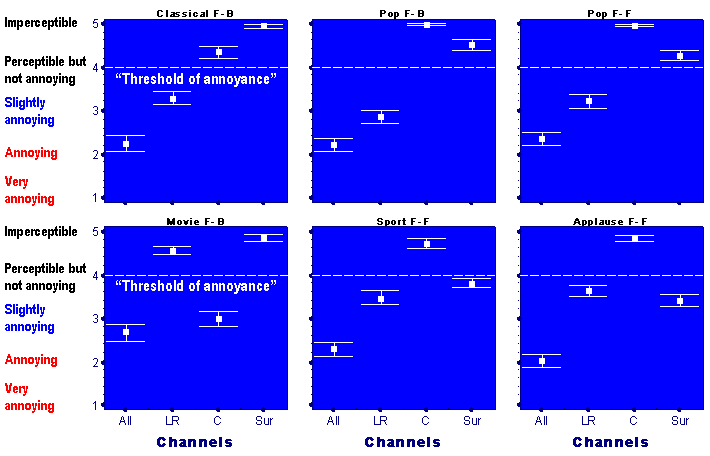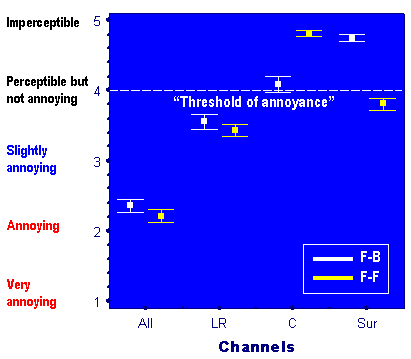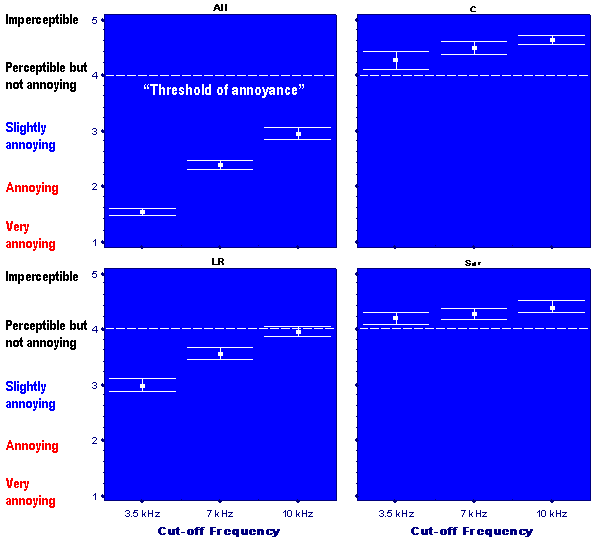Reports on Progress:
High-frequency limitation effects
 Fig.1 Degradation of Basic Audio Quality for different programme material (mean values and 95% confidence intervals). Scores averaged for all cut-off frequencies (3.5, 7 and 10 kHz).
Fig.1 Degradation of Basic Audio Quality for different programme material (mean values and 95% confidence intervals). Scores averaged for all cut-off frequencies (3.5, 7 and 10 kHz).For classical music ('Classical F-B') simultaneous band-limitation of all channels ('All') caused substantial deterioration of basic audio quality. According to Fig. 1, this effect was graded as almost 'Annoying'. Limitation of HF content of solely front left and right channels ('LR') also resulted in significant deterioration of quality, however deterioration of quality was less than in the previous case (mean value between 'Slightly annoying' and 'Perceptible, but not annoying'). The most interesting results (and perhaps surprising ones) were related to perceptual effects of band-limitation of the centre channel ('C') and the surround channels ('Sur'). In both cases these effects were very small. It is possible to observe in Fig. 1 that for these cases the mean values and 95 % confidence interval limits are located higher than a "threshold of annoyance" represented by the dashed reference line. These results mean that band-limitation of the centre or of the rear channels for classical music caused only small deterioration of quality. For example, the perceptual effect of limitation of HF content in the rear channels was almost 'Imperceptible' for classical music.
Results obtained for both pop-music items ('Pop F-B' and 'Pop F-F') were similar to the results obtained in case of classical music. Simultaneous limitation of HF content in all channels caused the highest degree of degradation of audio quality. Band-limitation of the front left and right channels also resulted in considerable deterioration of quality, however not as severe as in the previous case. However, the effects of low-pass filtering of the centre channel were almost 'Imperceptible'. Band-limitation of the rear channels caused 'Perceptible but not annoying' effect even for the item with foreground content in the rear channels ('Pop F-F').
Simultaneous band-limitation of all channels for the 'Movie F-B' item' caused considerable degradation of quality similar in magnitude to the effects of simultaneous band-limitation of all channels observed for other items. However, band-limitation of solely the front left and right channels or solely the rear channels caused small changes in quality. In contrary, band-limitation of the centre channel resulted in substantial deterioration of quality. This effect was related to easily perceivable effects of low-pass filtering of the centre channel due to its loud content (dialogue).
Results obtained for the last two items ('Sport F-F' and 'Applause F-F') are quantitatively similar to the results obtained for classical music item and both pop-music items. The only difference can be observed when comparing scores corresponding to band-limitation of the rear channels. It can be noted in Fig. 10 that limitation of HF content in the rear channels caused some annoying effects (scores below the "threshold of annoyance"). These effects were probably caused by easily perceivable effects of low-pass filtering of the rear channels due to their loud and clear content (foreground content).
It is also interesting to study the obtained results from point of view of the spatial characteristics of programme material. For example, further inspection of Fig. 1 shows that for all three items having F-B characteristic the band-limitation of rear channels had small effect on degradation of audio quality (scores above the dashed line) but for two items having F-F characteristic this effect caused more significant degradation of quality (scores below the "threshold of annoyance").
 Fig. 2 Degradation of Basic Audio Quality avaraged for programme material of different spatial characteristic
Fig. 2 Degradation of Basic Audio Quality avaraged for programme material of different spatial characteristicThe centre channel is "robust" to band-limitation both for F-B and F-F items except the 'Movie F-B' item. This result shows that it might be useful to introduce a new sub-category of F-B characteristic, namely a "F-B with prioritised centre channel". This category might be used to represent not only movies with the dialogue, but general types of F-B recordings with the loud centre channel (for example classical music with a loud soloist in the centre channel). The results of HF limitation of different channels on audio quality of programme material having different spatial characteristic are clearly presented in Fig. 2. It is interesting that band-limitation of all channels and band-limitation of front left and right channels caused similar effects for material having both F-B and F-F characteristic. However, in case of the centre channel and surround channels these effects are different. The difference between results for the centre channel is clearly related to the previously discussed effect of degradation of quality in the centre channel of the Movie F-B item. The difference between results for surround channels may be explained by the fact that in case of F-F material any effects of limitation of bandwidth in the rear channels are more easily perceivable due to the relatively high loudness and clear audio content of the rear channels as opposed to F-B material.
 Fig. 3 Degree of degradation of Basic Audio Quality for different groups of channels at different cut-off frequencies
Fig. 3 Degree of degradation of Basic Audio Quality for different groups of channels at different cut-off frequenciesFig. 3 shows the scores obtained during the listening test presented separately for different cut-off frequencies and different groups of band-limited channels. These results basically confirm conclusions drawn from plots discussed previously that regardless of the cut-off frequency band-limitation of all channels or band-limitation of front left and right channels caused significant deterioration of audio quality. It is also possible to note that band-limitation of the centre channel or band-limitation of the surround channels even down to 3.5 kHz did not, in general, cause any annoying effects. This effect was independent of the value of the cut-off frequency.
 Fig. 4 Degradation of Basic Audio Quality (for clarity this plot does not show factorial interactions)
Fig. 4 Degradation of Basic Audio Quality (for clarity this plot does not show factorial interactions)The most important outcomes of this experiment can be summarised graphically by means of Fig. 4 which shows global effects of limitation of HF content for different groups of band-limited channels. For clarity this figure does not show interactions with other experimental factors, and therefore to some extent "over-simplifies" results. However, it gives a clear indication of what the "average annoyance" was across a range of programme material, which might be especially useful for broadcasters. It is clear that the worst result (highest degradation of quality) occurred when all channels were filtered simultaneously ('All'). Band-limitation of the solely front left and right channels ('LR') also gave rise to significant deterioration of audio quality but not as large as in the previous case. However, band-limitation of solely the centre channel ('C') or band-limitation of solely the surround channels ('Sur') caused perceptible but not annoying effects for most of programme material (scores above the "threshold of annoyance").
